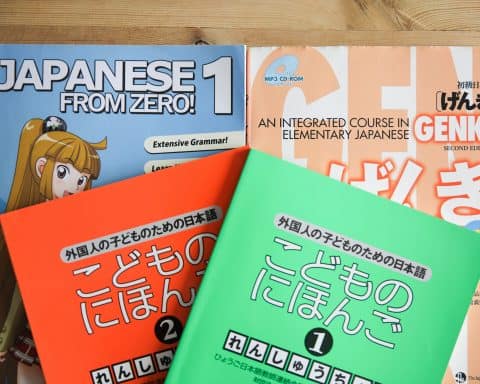Haven’t managed to get to Japan recently?
No problem! Other than experiencing Japan from home, I’ve decided to help you study Japanese by collating the very best online Japanese learning resources. So until you can practice Japanese under the cherry blossom, we’re going to find the best alternatives online.
Quick note: If you are struggling to stay focused, here are 10 tips to keep motivated while studying Japanese!
How hard is it to learn Japanese online?
The first thing to remember is that the key to learning any language is immersion and repetition. That’s especially true when you aren’t living in the country.
The one big problem you might face with learning Japanese on a computer is motivation. If you aren’t living in Japan, you might struggle to put your skills to use and ultimately end up wondering why you decided to learn it in the first place.
So set yourself a goal no matter how small (in fact mini goals might be more motivating) and stick to it. Whether it’s to learn Japanese to watch anime, to start a conversation with your Japanese friend, or to become a Japanese translator, you need to start somewhere.
If you’re looking for a great place to start, Tofugu is an incredible springboard to the world of the Japanese language. Take a look at our thoughts further down the page!
Who is this list for?
This list will be helpful for those just starting their Japanese learning journey and those who are further in. You’ll notice many of the resources cater to beginner and advanced abilities and specialize in more than one aspect of learning Japanese (Reading, Writing, Speaking, Listening)
Best Japanese resources for reading
To stand any chance in your Japanese learning journey, you’re going to want to learn how to read the Japanese alphabet.
The Japanese language is split into three separate scripts:
- Hiragana – Used to phonetically spell out Japanese words.
- Katakana – Used to phonetically spell out foreign words.
- Kanji – Each character represents a single word.
As some of you may know, Hiragana is typically the first of the three alphabets learned, followed by Katakana and finally kanji.
The first two can be learned in about a month (Give or take a few weeks depending on how hard you study) whereas kanji will take a lot longer.
If you’re just starting out, take my advice and get learning Kanji as soon as possible. It will open up a whole host of possibilities and help enrich your learning experience from the very beginning.
In the meantime, whilst you’re frantically learning over 3,000 Kanji that not even all Japanese adults know, furigana will be your best friend while reading.
Furigana is a Japanese reading aid where Katakana and Hiragana will be displayed above the kanji allowing you to read without trouble. There are even browser extensions to help you with this which we’ll get to later.
Keep in mind that many of these suggestions can also benefit your speaking (if you read aloud), writing (if you copy what you see onto paper), and listening (if you have a Japanese learning partner).
1. Nippon Talk – Day-to-day Japanese blog

Nippon Talk is a great website to read about the daily affairs of someone in Japan.
I like to think of it as an old-style blog where people would just chat about their day. Luckily for us, it makes for some absolutely perfect reading practice. And to top it off, they have the English translation underneath!
Don’t let this make you a lazy reader, though. But I do understand it’s comforting to have for someone who’s just started learning Japanese.
According to the website archives, it seems to have been last updated in 2016 which means it’s likely we won’t be getting more content anytime soon, but we still have over 3 years of daily content though. Plenty to go through for the time being.
You’ll have to know Hiragana and Katakana as well as a fair amount of simple Japanese vocabulary.
That said, if you don’t know the vocabulary it’s the perfect excuse to learn more and also a great way to practice your alphabets.
Some of the sentences are quite long in places making it a challenging activity for beginners. But I think If you’re looking to challenge yourself fairly early on in your journey (which you should be) then something like this is perfect practice.
Unlike a lot of upper-beginner Japanese activities, I found this one really interesting. You’re reading about real-life situations that change daily.
…Unless you like reading about the man in the red car who ate 3 apples?
Level: Upper Beginner / Intermediate
Interest: 4/5
Also good for: Writing
2. CosCom – Short Japanese news stories
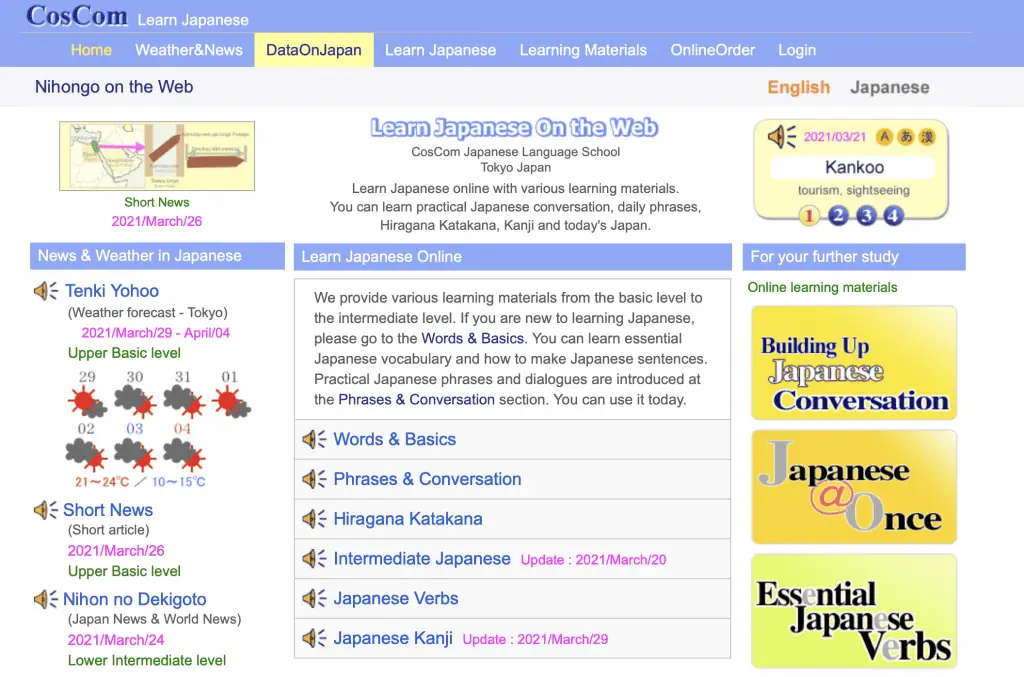
“We write the short articles as simply as possible so that beginners could read and learn Japanese.”
CosCom Japan.
Coscom is a website that helps you learn Japanese by providing you with quick news articles with translations and audio.
There’s even a tool in the top right corner that lets you change the alphabets used from Romaji to Hiragana and Kanji.
This nice little addition makes it a great tool to come back to once your reading has improved!
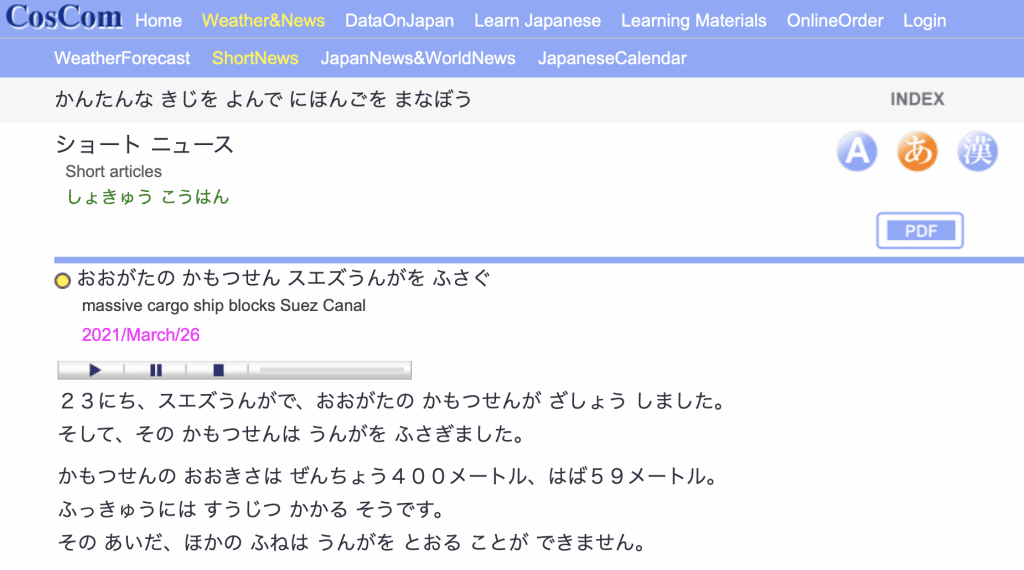
The difficulty level (according to them) Seems to start from upper basic and work its way up from there.
Im particulary a fan of their Short News section, but the entire website is well worth checking out.

The most recent two articles are available for free and the rest have to be accessed through membership. See how you get on with the articles and if it seems like something you might be interested in, go for it!
The site is nicely put together and easy to get around no matter what level of reading you have.
I think that having only a few news articles for free is slightly frustrating, but they are daily and if you add them into your Japanese learning routine it does make a nice addition. If you read the newspaper, just make sure you read this after and it’ll feel like you’ve not lost any time.
The added bonus of being able to change your script with any article is where this website truly shines for beginner, intermediate, or advanced Japanese students.
Level: Varies, but fantastic for beginners
Interest: 3/5
Also good for: Listening
3. NHK Easy News – Easy-to-understand Japanese news articles

A little like our last offering, but on a far bigger scale.
In fact, I wouldn’t be surprised if you’ve heard of NHK News already, even if you’re new.
NHK Easy News is a Japanese news website written specifically in easy-to-understand kanji and furigana and was designed with elementary school children and foreigners learning Japanese in mind.
It has real, up-to-date stories so the topics can be anything from finance and the economy to the environment or88 war.
Some of these topics are bound to have words you won’t yet understand, but instead of seeing that as a negative thing, you should use it as an excuse to increase your Japanese vocabulary knowledge.
Unlike Coscom, NHK Easy News lets you see and read the whole article, and they aren’t particularly short either.
Good if you’re in the mood to dive in deep, but not great if you don’t have too much time.
It does however have an audio file of the article so you can listen along at the same time. I’ve found the audio readings to be slow enough and clear enough to understand even at a higher beginner level.
Besides, if you find a word you’re unsure of you can simply pause the audio and research the word in Jisho.
You’ll probably get the most out of this resource if you’re an intermediate-level reader with some good vocabulary knowledge. But like I said, it’s accessible at any level once you know the two basic alphabets.
Level: Intermediate
Interest: 3/5
Also Good for: Listening
4. Bauddha – English books translated into Japanese

At first glance, the site might look a little intimidating.
That’s because it’s aimed at upper intermediate – advanced learners.
But don’t let that put you off if you aren’t quite there yet. It still has a lot to offer in terms of vocabulary building.
Bauddha gives a side-by-side translation of an English book translated into Japanese. Which to be honest is pretty cool!
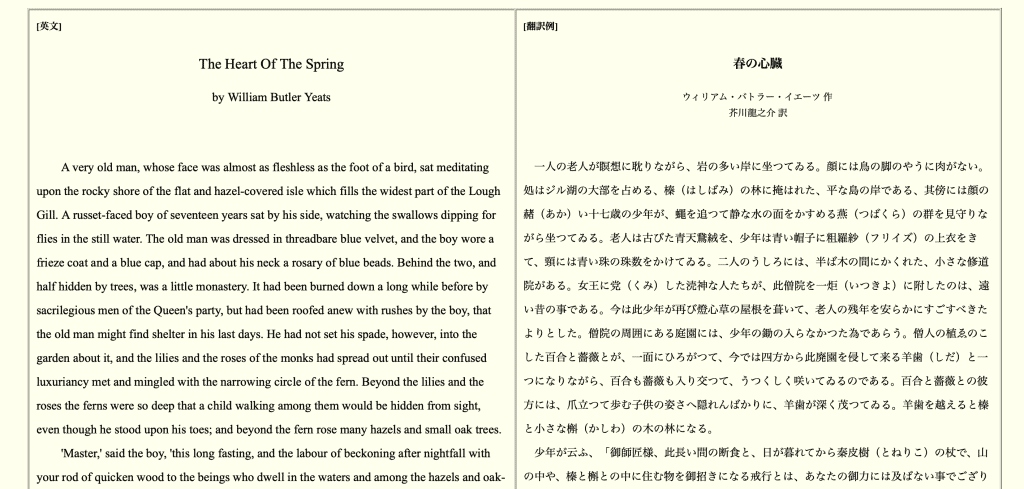
But as we all know, seamless Japanese translation isn’t easy at the best of times so it’s not ever going to be an exact translation.
Like I’ve said before, don’t let the ‘Instant translation’ allow you to become lazy even at an advanced level. It’s often helpful to intentionally seek out contextual translations to help you understand a word specifically how it’s been used.
If you like some of the books that are translated, you’ll probably really enjoy this site. It’s a bit too full-on for me, but that’s just because I’m not a fan of this type of learning.
Level: Advanced
Interest: 2/5
Also Good for: Speaking
5. Hiragana Times – Magazine aimed at foreigners learning Japanese

Hiragana Times is a well-known Japanese magazine that’s been established since 1986.
They focus on 4 mediums to help you learn Japanese. Hiragana Times being one of them.
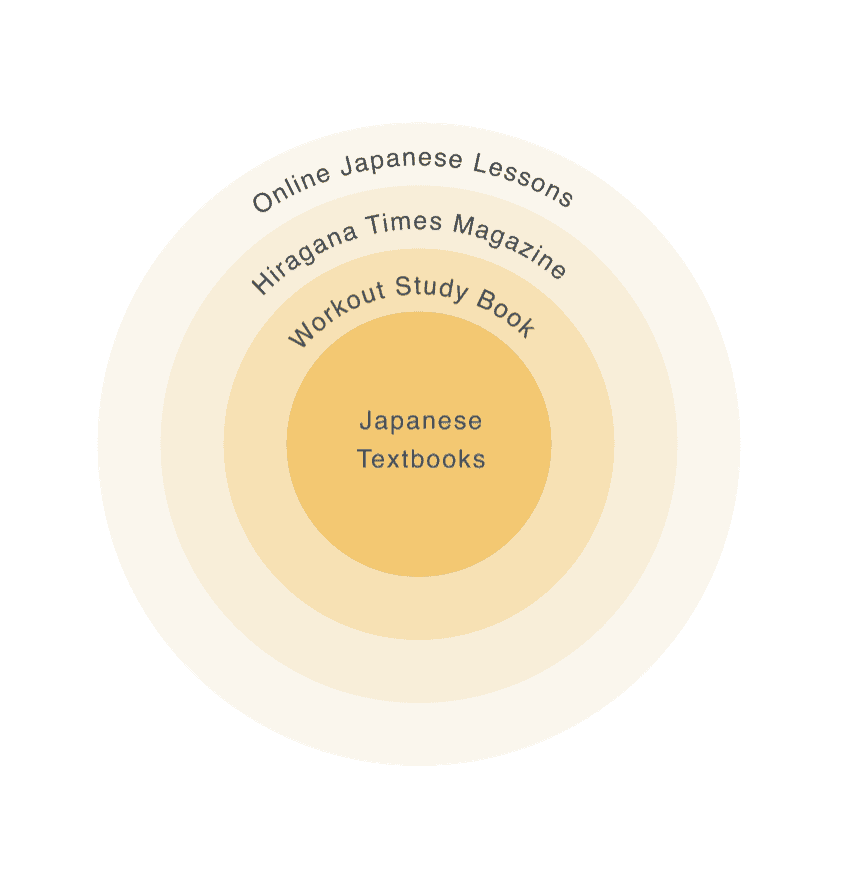
As you can see their most important learning material is Japanese Textbooks. The textbooks have their own individual workout study books with answers.
Hiragana times magazine is next and gives you a peak into Japanese culture whilst practicing your reading.
Finally, they offer some online Japanese lessons to help polish your skills.
The Hiragana Times magazine costs about ¥6,000 (About $55) a year for digital or print, and ¥10,000 (About $90) for both. It can be viewed on IOS, Android, and in PDF format on your computer.
Level: Beginner
Interest: 4/5
Also Good for: Speaking
6. Comic Walker – 100’s of free Mangas

Tired of searching around the web for specific mangas? Comic Walkers got your back!
With over 700 pages worth of books and English translations, its a great way to improve your reading and expand your vocabulary with some slang terms you may not have come across.
Keep in mind that not all books have been translated into English and the ones that have might not all have the same quality.
Definitely not one for the beginners
Level: Beginner
Interest: 4/5
Also Good for: Speaking slang to the cool Japanese friends you don’t yet have.
7. Traditional Japanese children’s stories

Everyone knows classics like momotarou, and it turns out that some other traditional Japanese children’s stories are quite easy to understand. Or at least use language you’re likely to recognize.
The Traditional Japanese children’s stories website features 16 stories with broken-down keyword explanations of the harder phrases.
What’s even better is that an English translation is written underneath! This lowers the barrier to entry and makes it a beginner-friendly resource for learning.
Just make sure you know your hiragana and katakana!
Level: Beginner
Interest: 3/5
Also Good for: Speaking
8. Wani Kani – The best way to learn kanji

2,000 kanji.
6,00 vocabulary words.
In just over a year.
Hands down this is my favorite way to learn kanji.
Is it possible? It very well might be if you have the time and dedication to see it through.
The beautiful UI doesn’t go amiss either.
WaniKani is one of those websites that focuses on only one thing but does it exceptionally well.
The ‘WaniKani’ method is split into 4 parts:
- Mnemonics – There are Mnemonics to teach you literally every single Kanji and vocabulary word on the whole site. These should help you learn at a more efficient rate but as we touched on earlier, everyone learns in different ways.
- Radicals – Before you learn the most difficult Kanji on record, you’ll learn building blocks to help your progression. Think of these like mini Kanji.
- Kanji – There are over 2,000 on the site that have been hand-picked and arranged in a specific way to help you learn efficiently. According to their site, this should take about a year and a half of learning! It takes a Japanese school child about 8, so don’t feel too annoyed 😉
- Vocabulary – Okay so WaniKani doesn’t just teach you Kanji, it also teaches you some Vocabulary. If you chose this resource to help you learn Japanese online, you’ll be learning over 6,000 words!
Level: Beginner – Advanced
Interest: 4/5 (I like how the website looks, what can I say!)
Also Good for: Writing – You really should be writing these down at the same time if you want to make the most of things!
9. Furiganify! – Kanji converter safari add-on

If you don’t yet know thousands of kanji, then this Safari add-on is bound to save you a few headaches.
Just turn the extension on and Furigana will now be displayed above any kanji displayed on any web page.
Handy, aye!
Level: Beginner – Advanced
Interest: 5/5 – What a fantastically helpful tool!
Also Good for: Writing
Best online Japanese resources for writing
Learning to write Japanese is a bit harder to do online, especially considering all the specific strokes needed for kanji.
That said, there are lots of online resources that can help you understand sentence structure much better than you do now.
1. Duo Lingo – The complete learning package?

Is Duo lingo the best way to learn Japanese online?
Well according to its subtitle, yes!
I’d probably call it the most well-known learning platform for Japanese, but not necessarily the best for intermediate-advanced learners.
It’s extremely user-friendly and to be fair to duo-lingo it has a very well-put-together course.
It lets you practice your speaking, writing, reading and listening in all sorts of scenarios and as of April 2021 there are 9.84M global learners on the site so clearly, they’re doing something right!
Duolingo was a great place to start my Japanese learning journey and if you’re going through this list and still have no idea, start with this.
It did however become a little repetitive towards the mid-stage and there were a few sentences that I can’t imagine id say in several lifetimes. Japanese or English!!

Level: Beginner – Advanced
Interest: 3/5 – It’s great for beginners, but may get repetitive nearer the end.
Also Good for: Reading, listening, Speaking
2. lingo deer – Learn languages smarter, not harder!

Next up we have something that may just beat Duolingo at its own game.
Is Lingodeer better for learning Japanese than Duolingo?
From what I’ve seen, I prefer it.
The scenarios you’re given are much more relevant and usable in real life, and the quality of voice recording is far superior.
Duolingo also misses out on one key area of Japanese.
Not teaching Hiragana, Katakana, or Kanji by themselves.
In fact duolingo goes straight into teaching you words before you know any alphabets.
Maybe some people learn better this way, but it’s not for me and it turns out this is the general consensus in the online community too.
In the battle of lingo deer vs Duolingo, lingo deer takes the win!
In any case, try both and see which one you get on with more.
Level: Beginner – Advanced
Interest: 4/5 – I prefer their learning style to Duolingo so it keeps my interest for a longer period
Also Good for: Reading, listening, Speaking
3. Jisho – The best Japanese dictionary

At some point whilst learning Japanese you’ve no doubt plugged a word you’ve never heard of before into a Japanese translator.
Or you’ve typed in an English word to google translate and hoped for the best.
Introducing Jisho! The world’s best Japanese dictionary.
Jisho users can search by English, Japanese, Romaji, Words, Text, or even drawings.
But the true power of Jisho is how it contextualizes answers, something google translate cant do.
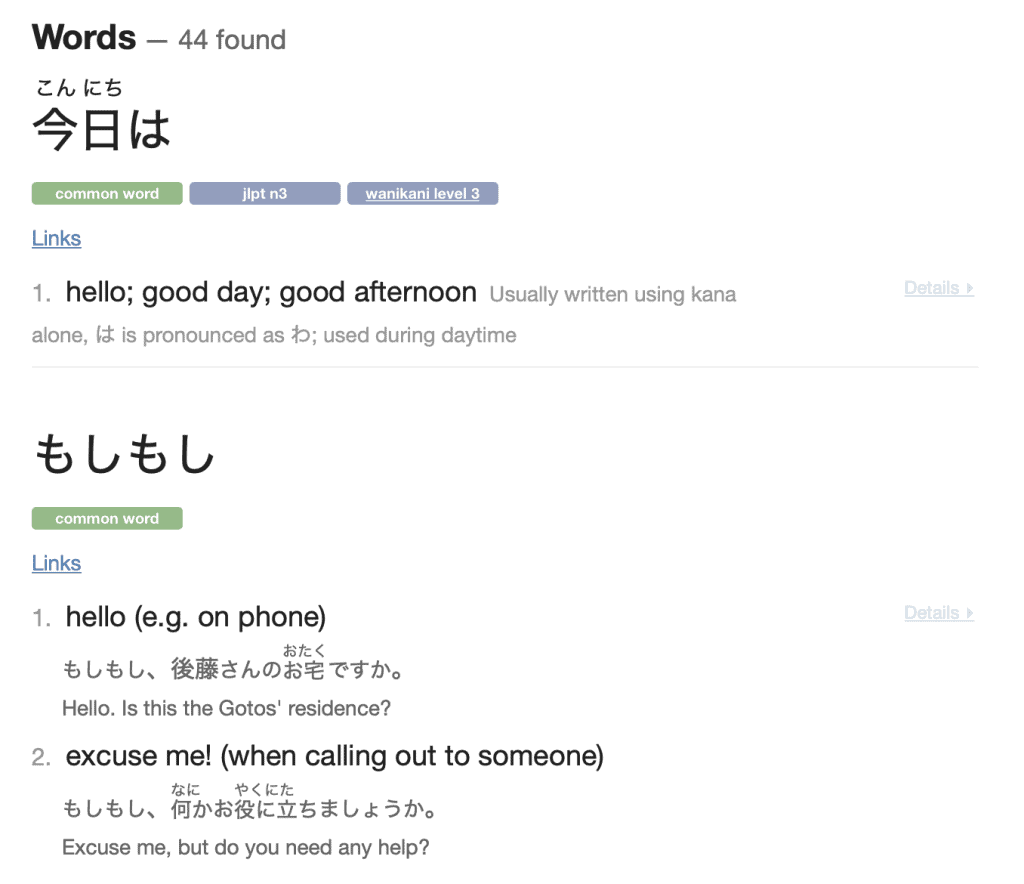
When I type in the word ‘Hello’ I am given answers based on how I use the word.
In this case, we are given もしもし for use on the phone, and今日は for speaking in person.
It also shows us how common a word is, where it’s likely to appear in the JLPT, and when it comes up in WaniKani.
Level: Beginner – Advanced
Interest: 5/5 – Simply the best dictionary for Japanese on the web
Also Good for: Reading, Speaking
4. Tae Kim’s Guide to Learning Japanese – A solid way to learn Japanese Grammar

Tae Kim takes the crown for being the most comprehensible yet understandable grammar guide on the web.
I have found it an incredibly good way to build a strong grammar base to work from.
Tae Kim’s guide could have been in the reading section but writing has a way of cementing information into your memory more than reading, and Japanese grammar takes some time to get your head around.
A lot of time its context and experience that are the best ways to understand. Oh, and practice of course!
The grammar guide is just what it says, a guide. So it’s a good idea to do research and work outside of the reading you do here. But that’s pretty much the rule for any of the suggestions on this list!
Level: Beginner – Advanced
Interest: 2/5 – It may be a great guide, but that doesn’t mean grammar isn’t boring, haha!
Also Good for: Reading – there’s a book, too!
Best online Japanese resources for
listening
The first thing you’re likely to think when you listen to a native Japanese person speak Japanese is ‘Dam, that’s fast’.
But with a bit of practice, some slow audio tracks, and a repeat button, you’ll get there in the end.
1. Casual Nihongo – Learn natural Japanese
Casual Nihongo is a fantastic Japanese podcast to learn (you guessed it) casual Japanese!
Dai, the creator of the blog has added an extra level to the JLPT.

Nあ- is basically a cultural level because the podcast helps teach you natural Japanese, not just monotone ways to introduce yourself you’re likely to learn in the beginning.
Level: Intermediate -Advanced
Interest: 4/5 – Learn the basics first, but this will really help you feel like a native!
Also Good for: Speaking
2. Japanese Pod 101 – The best Japanese podcast

Each of the episodes is structured like proper lessons and there’s some really good knowledge to be had if you actively listen.
I’d make sure you have a pen and paper to write down little bits that interest you at the same time.
The Japanese Pod 101 website is full of great information as well.
- Short Audio & Video Lessons for Fast and Easy Learning – Short and to-the-point lessons.
- Study Tools for Rapid Learning – Words lists, slideshows, flashcards, line-by-line breakdowns, and slowed-down audio.
- Personalized Guidance from Your Own Teacher – You can learn in a 1-on-1 environment with your own teacher! They provide you with personal feedback, personalized programs, and weekly assignments.
I highly recommend their YouTube channel Learn Japanese with JapanesePod101 as well!
Level: Beginner – Advanced
Interest: 4/5 – Rita is our favorite host!
Also Good for: Writing
Best online Japanese resources for
speaking
Speaking Japanese is something that might be nerve-wracking for newbies.
You might be thinking ‘How can I practice speaking Japanese online?’
Luckily we’ve got a few resources to help you out!
1. Speechling – Analyse your voice recordings

Bit of an interesting one here!
Speechling is a free-to-use (With limitations) online platform for users looking to improve their pronunciation. Users can send up to 10 voice recordings per month which will then be analyzed and if needed, corrected, and finally spoken back by your Japanese tutor.
Your tutor can correct your word pronunciation, intonation, rhythm, grammar and word choice.
Obviously, 10 voice recordings may not be enough for you, and if you find yourself enjoying the platform then you may want to consider a premium subscription which allows for an unlimited amount.
Speechling has really hit a niche area of language learning and it’s definitely something worth trying if you don’t have anyone else to speak with in from Japan.
Level: Beginner – Advanced
Interest: 5/5 – It’s there when you need it and personalized to you!
Also Good for: Listening
2. Japanese Swotter – Repeat after me

Don’t have the time to study Japanese?
Or simply want to study it whilst you’re doing other things?
If either one of those is true, the Japanese Swotter might be what you’re looking for.
Each word or sentence is followed by a pause allowing you to practice your speaking and focus on your pronunciation.
It’s a great way to go over vocabulary and practice pronunciation on the move. Their Patreon also has full transcripts and translations available if that’s something you want.
Level: Beginner – Advanced
Interest: 4/5 – It’s great for when you want to passively study Japanese or just want to get in as much practice as possible.
Also Good for: Listening
3. Busuu – Japanese in 10 minutes a day

Speak Japanese with confidence in 10 minutes a day.
Is it possible?
Honestly, I’m not totally sure it’s enough if you want to be fluent anytime soon. But Busuu and their community of over 100 million language learners seem to love the idea, so who am I to disagree?
And to be fair, 10 minutes out of your day isn’t too much so you should definitely give it a go and see if this way to learn Japanese works for you.
One thing that’s great about Busuu is its barrier of entry.
ANYONE can give up 10 minutes a day to learn a language and if you don’t think you can, then you probably don’t want to learn that much.
Learning a language is a big commitment and you need to stay dedicated in the long run if you want to achieve your goals.
Level: Beginner
Interest: 4/5 – 10 minutes a day makes this platform a winner
Also Good for: listening, reading, and writing.
4. Tandem – Japanese language exchange

Tandem is a language exchange app where you are able to speak with a Japanese local whilst both improving your language knowledge.
It’s also a great way to break down cultural barriers and learn about Japan in a deeper way than you would with just a textbook.
Level: Beginner – Advanced
Interest: 5/5 – You’ll get to talk to real people, and maybe make a friend for life!
Also Good for: listening, reading, and writing.
5. Italki – Speak with a Japanese teacher

Let’s be honest, this is probably the best way to learn Japanese.
Each of the teachers set their own hourly rates and will normally offer a trial rate of significantly less.
The great thing about Italki is they’ll always be someone to teach you more than you already know, making it a perfect choice for anyone whether you’re a beginner, intermediate, or advanced.
You can also choose to be taught by a professional teacher or an Italki Community tutor. The latter is a fine choice to practice conversational skills whilst the accredited teacher may be able to help you with specific problem problems.
If you can afford even an hour a week alongside the rest of your studies, I’m sure it will pay absolute dividends to your confidence further down the line.
Level: Beginner – Advanced
Interest: 5/5 – Always something new to learn and easy to find a teacher to fit your learning style.
Also Good for: listening, reading, and writing.
Best Japanese blogs to follow
A Day of Zen – Shameless plug?

If you don’t follow us already, sign up below to receive updates on when we release new content! (No spam, and worth your time, promise!)
Planning a trip to Japan? We got you covered.
Want to understand Japanese culture? We do that here!
Interested in buying Japanese gifts Then take a look!
Tofugu – Culture and Langauge blog

A Japanese culture and language blog that has a great sense of style and a seasonal round-up of the best resources to learn.
Definitely worth checking these guys out!
Honorable mention
Japanese stack exchange

If you’re a coder, you more than likely come across stack overflow.
The Japanese Language stack exchange is a question-and-answer site for students and learners who want to discuss a specific point of the Japanese language.
If you have a specific question or example of Japanese you don’t understand, this is the best place to ask it.
So, what’s the best way to learn Japanese online?
Japanese is a complicated language and if we’re being honest, nothing is going to beat face-to-face lessons with a Japanese teacher.
Ideally, you’ll be living in Japan and studying at a Japanese school, but more often than not it’s not going to be a possibility.
Our best advice is to try out a collection of the platforms listed in this guide and find out what works best for you.
The key to learning Japanese is immersion and repetition. So perhaps choosing more than one of these platforms is the best way to stop you from burning out prematurely.
Now I want to hear from you!
What’s your favorite online resource for learning Japanese?




